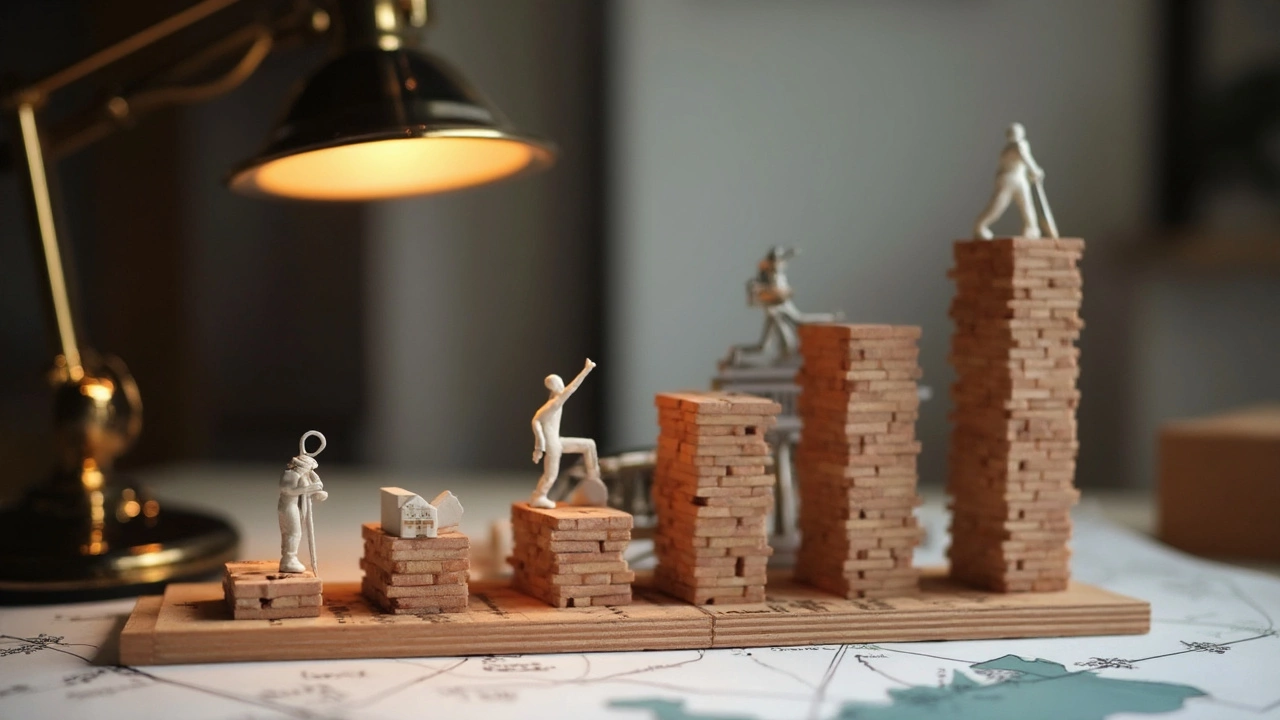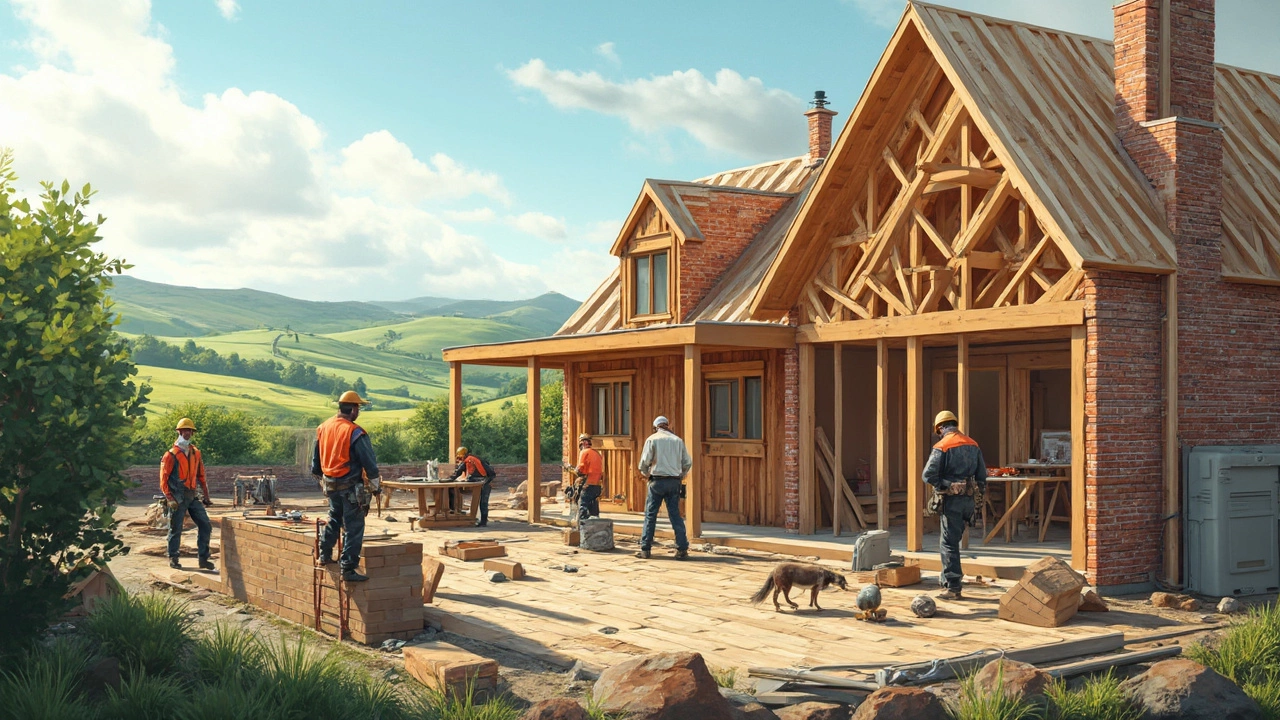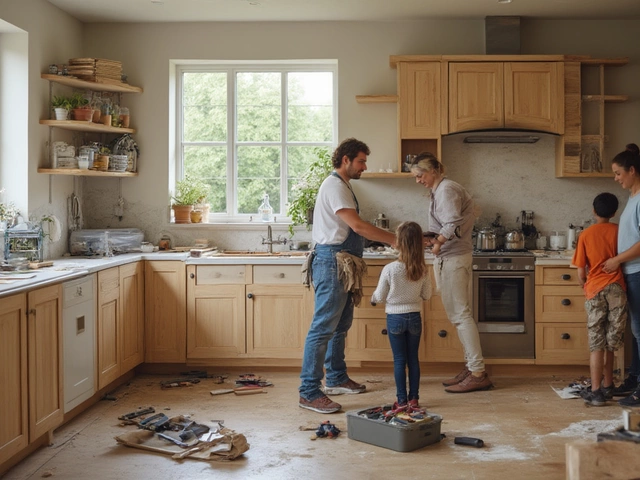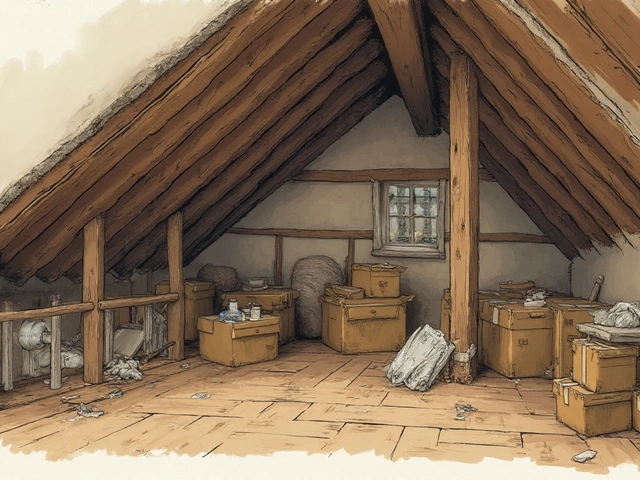When it comes to new builds, everyone knows it's costly, but ever wondered which part actually breaks the bank? Spoiler alert: It's not the fancy materials or the location. More often than not, it's the labor costs that sneakily climb to the top of your expense list.
Think about it. You're paying not just for the brains designing your home but also the skilled hands transforming those blueprints into reality. Skilled labor is essential, but it doesn't come cheap, and almost always, it’s a significant portion of your budget. Let's face it—good work deserves good pay, and in construction, that's a hard rule to bend.
But don't worry; it's not all financial doom and gloom. With smart planning and a few trade secrets, there are ways to manage these costs effectively. Whether it's finding the right contractor or tweaking your home's design, we'll walk through some neat tricks to keep your wallet happy while building the house of your dreams.
- The Land You Build On
- Materials That Matter
- Labor Costs: The Hidden Giant
- The Price of Permits
- Design and Architecture Fees
- Saving Tips for Your Build
The Land You Build On
Let's talk dirt—literally. The very ground you choose to lay your foundations on can shake up your budget in unexpected ways. While it might seem obvious that beach-front properties or urban city blocks come with higher price tags, even more surprising factors like soil conditions and zoning laws can end up costing you more than you'd think.
First up, location is a huge deal. Sure, everyone wants to be in the trendiest neighborhood or the most scenic spot. But know this: the closer you are to amenities like schools, shopping, and public transport, the more you'll likely pay. It's classic supply and demand with a side of geographical appeal.
Checking the Soil
Here's a kicker. Not all land is created equal. Before your dreams start reaching to the skies, there's the ground to consider. Soil testing is a must-do. If the land is rocky, swampy, or hard clay, expect extra charges for preparation. You might need to bring in special equipment or material to stabilize the foundation, and that turbulence can hit your wallet.
The Zoning Factor
Zoning laws are like the rulebook for your land. These dictate what you can or can't build. Need to make changes to build your dream house? More permits mean more fees. Sometimes, zoning adjustments require community approval, stretching both your timeline and budget.
Pros and Cons of Different Land Types
| Land Type | Pros | Cons |
|---|---|---|
| Urban | Close to amenities | Higher costs, smaller lots |
| Suburban | More space, quieter | Longer commutes |
| Rural | Privacy, low cost | Limited access to services |
The bottom line? While land might not be the outright most expensive part of new builds, it comes with hidden costs and surprises. So do the homework, know what you're getting into, and you'll avoid any nasty financial shocks that might dig too deep into your construction savings.
Materials That Matter
So, you’re knee-deep in plans for your new build and trying to figure out what materials will cost you an arm and a leg, right? It’s a crucial aspect because the stuff you choose can seriously impact not just your wallet but also how your home feels and functions. Let’s break it down.
Framing and Foundation
One of the first big expenses is the structure itself—think framing and foundation. Lumber prices have been on a rollercoaster in recent years, and even though they’re not as sky-high as before, they’re still one of your larger line items. Steel framing is another option but generally costs more upfront.
Roofing Materials
When it comes to roofing, your choice likely boils down to personal taste and budget. Asphalt shingles are a go-to for many because they’re cheap and effective. If you’re looking for longevity and aesthetics, metal or tile roofs may tempt you but brace yourself—they’re pricier.
Windows and Insulation
Don’t skimp on materials like windows and insulation; they’re critical for energy efficiency. Energy-efficient windows can save you on heating bills, but expect to pay more for the investment upfront. Insulation types vary, but spray foam often sits on the higher end.
Finishing Touches
Your choice of finishes—flooring, countertops, cabinetry—can greatly influence your overall expense. Hardwood floors and granite countertops may scream luxury, but they also hammer your budget. Opt for engineered wood or laminate to get a similar look for less.
Here’s a quick look at some average costs for common materials:
| Material | Average Cost per Sq Ft |
|---|---|
| Lumber Framing | $3 - $5 |
| Asphalt Shingles | $1 - $4 |
| Energy-Efficient Windows | $15 - $20 |
| Granite Countertops | $40 - $60 |
| Hardwood Flooring | $8 - $14 |
Choosing wisely can mean the difference between staying comfortably within budget or reaching for those credit cards more often than you’d like. Always keep an eye out for deals, and never hesitate to ask for recommendations on cost-effective options. These choices will impact your bottom line today and how happy you are with your home forever.
Labor Costs: The Hidden Giant
So, we've all heard that labor can make up a huge chunk of construction expenses, but how huge are we talking? On average, new builds see labor costs eating up 30% to 40% of the total budget. Crazy, right? And this is because you're not just paying for someone to swing a hammer—you're covering skills, experience, and sometimes, specialized expertise.
Now, let's break it down. Different trades in construction bring different costs. For instance, you'll typically have your general contractors, electricians, plumbers, and carpenters. Each of these workers brings a specific skill set and thus a different pricing scale. Want to know a little secret? Electricians and plumbers often top the list in terms of hourly rates, but they’re essential, so cutting corners here is a no-go.
The Impact of Location
Your geographical location is like a price dial affecting how much you'll shell out for labor. Urban areas with a higher cost of living like New York or San Francisco see steeper labor prices compared to small towns. Makes sense, lower living costs mean lower wages.
Seasonal Fluctuations
Believe it or not, seasons can impact labor costs, too. Peak seasons in construction mean busier schedules and potentially higher rates. If you're thinking of saving a buck, consider scheduling some of your work during the quieter winter months when builders might be hunting for gigs to keep workers busy.
Ways to Save
- Get multiple quotes: This old trick never fails. Compare contractor estimates to get a feel for average costs.
- Consider owner-builder options: Taking on part of the project management yourself might save you some dough, though it requires more legwork.
- Package deals: Some contractors offer discounts if you bundle services, like combining electrical work with plumbing from the same provider.
In the end, knowledge is your best tool. Understand what you’re paying for and where there's room for negotiation. It's your money, after all, and a little insight never hurt anybody building their dream pad.

The Price of Permits
When you're diving into the world of new builds, permits are one of those unavoidable expenses that often go overlooked until you're neck-deep in planning. In essence, permits are like the backstage passes to legally kick-start your construction project. But what exactly are you paying for?
What Are Building Permits?
Simply put, building permits are official documents issued by your local government, allowing you to proceed with specific construction work. They ensure that your project meets local standards for land use, zoning, and construction safety. In other words, they're meant to keep both you and your soon-to-be neighbors safe and sound.
How Much Do Permits Cost?
The cost of permits can vary widely depending on your location and the scope of your project. Some might set you back a few hundred dollars, while others can climb into the thousands. In major cities, expect to dish out up to 1% of your total construction cost on permits. This percentage might seem small, but it adds up, especially for large projects.
Factors Affecting Permit Costs
- Location: Urban areas tend to have higher permit fees compared to rural locales due to stricter regulations and higher administrative costs.
- Project Complexity: The bigger and more complex your build, the more you’ll pay. Simple structures are generally cheaper to permit.
- Specific Regulations: Special permits might be needed for additions like pools or solar panels, each coming with its own price tag.
Tips for Navigating Permit Costs
Planning ahead is crucial. Here are a few tips to keep in mind:
- Do Your Research: Check local building department websites for permit requirements specific to construction costs in your area.
- Get Professional Help: Sometimes, the paperwork can get overwhelming. Hiring someone familiar with local codes can save you time and potential fines.
- Bundle Permits: If possible, combine related permits into one application to minimize fees and paperwork.
Remember, while skipping permits might seem like a sneaky way to save, it usually costs more in the long run, especially if you face fines or are forced to undo parts of your project to comply with regulations.
Design and Architecture Fees
Design and architecture might sound like the cool, creative part of a new build, and while it’s undeniably fun, it’s also where the bills start adding up. Why does it cost so much, you ask? Well, a lot goes into turning vague ideas into detailed plans that a builder can actually follow.
The truth is, architects don’t just draw up nice-looking blueprints; they also consider structural integrity, local building codes, and environmental factors. New builds come with a set of rules, and skipping on professional design help might seem tempting but can end up being more costly in the long run.
What's In The Fee?
Generally, architects charge based on a percentage of the total construction costs. On average, you’re looking at anywhere from 5% to 15% of your project budget going here. They’ll usually offer different service packages, ranging from basic design to full project management, with added fees for extras like interior design.
Let’s take a quick look at what these services could include:
- Preliminary Designs: Initial sketches and layouts based on your requirements.
- Detailed Blueprints: Comprehensive plans that construction crews need to build.
- Interior Design: If you choose to extend services to interiors, this is where you'll plan your layout choices, materials, and furnishings.
- Project Management: Overseeing the build to ensure everything goes according to plan, saving you potential headaches down the line.
Why It’s Worth It
Yes, the architecture fee might seem steep, but it's crucial for ensuring that your new home is not just aesthetically pleasing but also safe and compliant with construction costs. A good architect will save you money on unforeseen modifications and help you avoid the costly mistake of cutting corners.
So, when budgeting for your new build, set aside a decent fraction for the design and architecture. It’s not just part of the expense; it's an investment into the smooth running, style, and stability of your future home.
In fact, according to a 2023 survey by Home Builders & Architects, around 82% of first-time builders admitted that having professional design guidance measurably reduced hassles and unexpected expenses.
Saving Tips for Your Build
Building a new home can feel like you're watching money fly out the window, but there are plenty of ways to keep costs in check without sacrificing quality. These handy savings hacks will help ensure your new build doesn't break the bank.
Plan and Prioritize
Before anything else, decide on a realistic budget and stick to it. Make a list of must-haves and nice-to-haves. By knowing what's essential, you can avoid getting swayed by luxury finishes that weren't part of the original plan.
Be Smart with Materials
Eager to find where to cut costs? Review material choices. Research alternative materials that offer a similar look but for a fraction of the price. For example, opting for laminate instead of hardwood floors can save you a bundle.
DIY Where Possible
Got some construction skills? Put them to use! Simple tasks like painting, landscaping, or even assembling cabinetry can save a considerable amount. Just leave the complex stuff, like electrical work, to the pros.
Shop Around for Contractors
Never settle for the first contractor you meet. Get quotes from several and compare. And don't forget to check references. A contractor who delivers quality work on time is worth their weight in gold.
Consider the Seasonal Savings
If you're flexible with your schedule, try building in the off-season. Construction is often cheaper in fall or winter when demand drops. Who knew a little bit of chill could save you a chilly sum?
Maximize Efficiency
Incorporating energy-efficient features isn’t just good for the planet; it’s good for your wallet in the long run. Consider investments in quality insulation, solar panels, or energy-efficient windows and doors. They might cost a bit more upfront but can lead to significant savings over time.
Whether it’s choosing the right materials or timing your project for maximum savings, staying smart about your spending and being flexible with choices are key to keeping your construction costs under control. Sometimes little tweaks can make a big difference in building your dream home efficiently.





